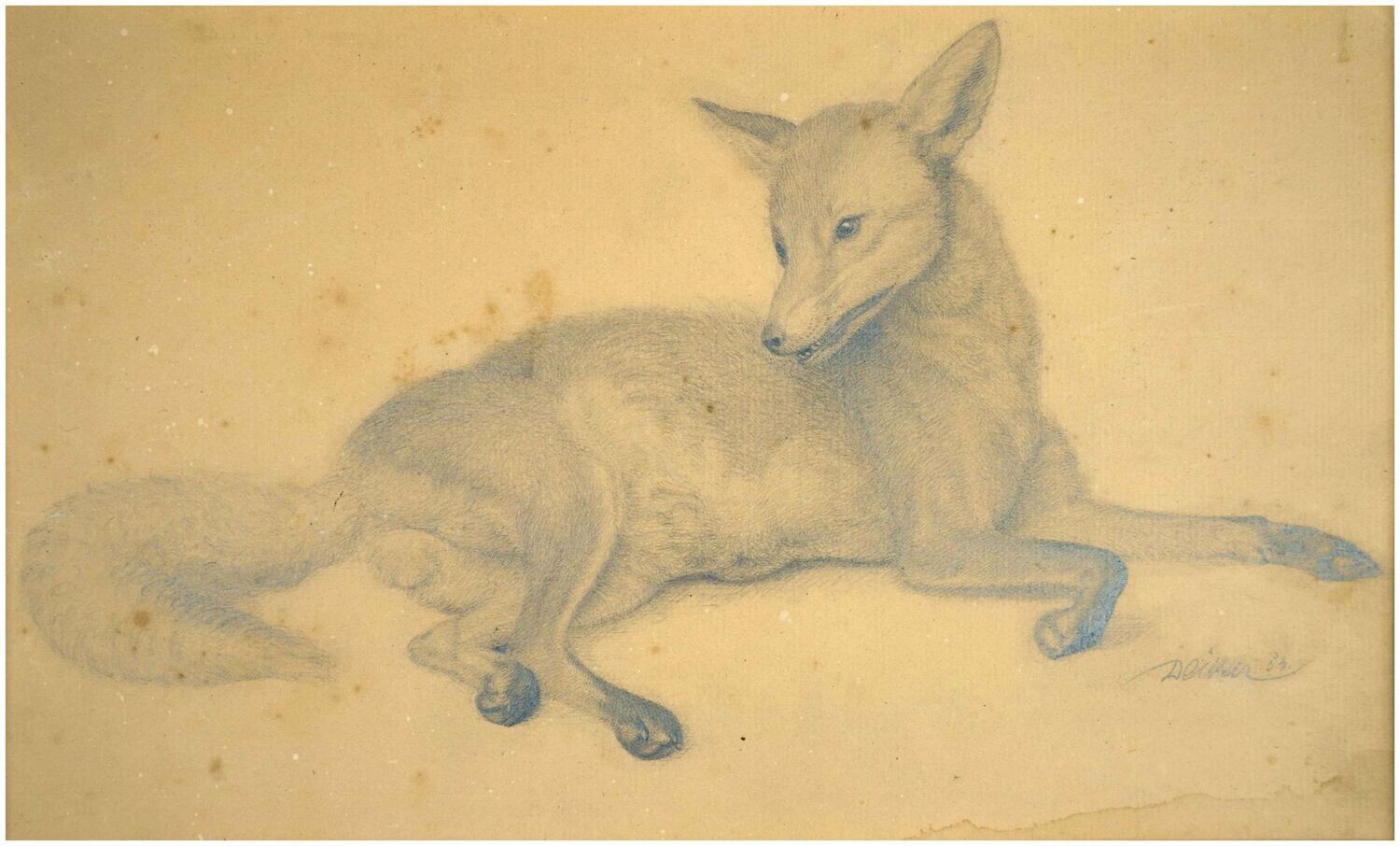Deiker, Carl Friedrich (1836-1892), Wachsamer Fuchs, 1854
Carl Friedrich Deiker(1838 Wetzlar - 1892 Düsseldorf). Wachsamer Fuchs. Bleistiftzeichnung auf braunem Papier, 18 × 29,5 cm (Innenmaß), 31,5 x 43,5 (Passepartout), rechts unten signiert und datiert „Deiker [18]54“.
- etwas stockfleckig, rechts unten mit leichtem Wasserrand
Exposé als PDF
- Die Psyche des Fuchses
-
Bereits bei diesem frühen Werk Carl Friedrich Deikers zeigt sich die vollendete Fähigkeit des Künstlers, Tiere darzustellen. Er bringt eine ganz neue psychologische Dimension in die Tiermalerei hinein, so dass regelrecht von Tierporträts gesprochen werden kann.
Schon aufgrund seiner naturalistischen Erscheinung wirkt der Fuchs wie lebendig. Jeder Muskelstrang, ja jedes einzelne Härchen ist ‚haargenau‘ getroffen, was ein intensives künstlerisches Studium der Tieranatomie und -physiologie voraussetzt. Seine eigentliche Lebendigkeit gewinnt der Fuchs aber nicht durch seine naturgemäße Erscheinung, sondern durch seine innere Regung: Ausgestreckt hingelagert, wurde er aus der Ruhe gebracht. Er wendet sich um und blickt mit gespitzten Ohren gespannt in die Richtung, aus welcher er etwas gewahrt hat. Dabei ist sein Maul leicht geöffnet und die spitzen Zähne entblößt als ob er knurren würde. Die Anspannung nimmt allmählich von seinem ganzen Körper Besitz. Während die Hinterläufe noch in einer von Deiker genau beobachteten entspannten Haltung liegen, ist der eine Vorderlauf bereits aufgerichtet, bereit eine Aufstehbewegung zu initiieren. Der Fuchs wirkt mit allen seinen Sinnen derart alarmiert, dass sich der Eindruck einstellt, sein Schwanz würde sich im nächsten Augenblick ruckartig bewegen und das Tier aufspringen.
Waren Wildtiere zuvor vor allem als Bestien dargestellt oder – oftmals zu karikierenden Zwecken – anthropomorphisiert worden, erkundet Deiker das ihnen eigene Wesen, indem er die psychischen Regungen der Tiere zu erfassen sucht. Das Wildtier ist weder bestialisch noch menschlich, sondern ein ganz eigenes Geschöpf, das von Deiker um seiner selbst willen gewürdigt wird. Damit bringt er die Würde des Tieres zur Darstellung und hebt die Tiermalerei auf ein ganz neues künstlerisches Niveau.
zum Künstler
Carl Friedrich Deiker war Sohn des Zeichenlehrers Christian Friedrich Deiker und der jüngere Bruder des Tiermalers Johannes Deiker. Neben dem familiären künstlerischen Unterricht, Christian Friedrich teilte sich zusammen mit seinem Bruder Johannes ein Atelier im Schloss Braunfels, besuchte Deiker die Zeichenakademie in Hanau und war ab 1858 Student der Kunstakademie Karlsruhe, wo er bei dem Landschaftsmaler Johann Wilhelm Schirmer lernte. Bereits im ersten Studienjahr war Carl Friedrich Deiker ein gefragter Künstler: Der Großherzog Friedrich I. von Baden, der Markgraf Max von Baden und Großfürst Michael von Russland erwarben Jagdstücke aus seiner Hand.
1859 erfolgte eine Studienreise in den Reinhardswald. So wie die Schule von Barbizon die Landschaft für die Landschaftsmalerei neu entdeckte, erschloss Deiker den Wald für die Tiermalerei.
Von 1861-64 führte Deiker ein eigenes Atelier in Karlsruhe, um dann nach Düsseldorf überzusiedeln, wohin ihm sein Bruder Johannes vier Jahre später nachfolgte. Deiker ehelichte eine Tochter des Landschaftsmalers Karl Hilger und verblieb bis zu seinem Tod in Düsseldorf. Mit dem Bild „Verfolgter Edelhirsch“ gelangte er 1868 endgültig zu internationalem Renommee und galt als virtuoser Neubegründer der Tiermalerei.
„Deiker brachte zuerst einen wirklich großen künstlerischen Zug in die Tiermalerei […].“
- Hans Vollmer
Ab 1870 beschickte er die akademische Kunstausstellungen in Berlin, Dresden, München und Hannover. Zudem war er eifrig als Illustrator tätig. Er zeichnete für die Gartenlaube, den Salon, das Universum und fertigte zahlreiche Vorlagen für die damals hochwertig illustrierten Jagd- und Tierbücher an. Auch war er selbst als Druckgrafiker tätig, während seine Ölbilder als Nachstiche von Franz Dinger kursierten.
Von 1865 bis 1892 war Deiker Mitglied in der Künstlervereinigung Malkasten .
Mit einer großen posthumen Gedächtnisausstellung in der Düsseldorfer Kunsthalle wurde 1892 das Lebenswerk Carl Friedrich Deikers gewürdigt.
Sein 1879 geborener Sohn, Carl Deiker, wurde ebenfalls Maler.
Auswahl an Kunstmuseen, die Werke von Carl Friedrich Deiker besitzen:
Hamburger
Kunsthalle / Kunsthalle Karlsruhe
/ Kunstmuseum Düsseldorf
/ Wallraff Richartz Köln
Auswahlbibliographie
H. Schmidt: Johannes und Carl Friedrich Deiker. Ein Beitrag zur Tier- und Jagdmalerei im 19. Jahrhundert, Wetzlar 1986.

